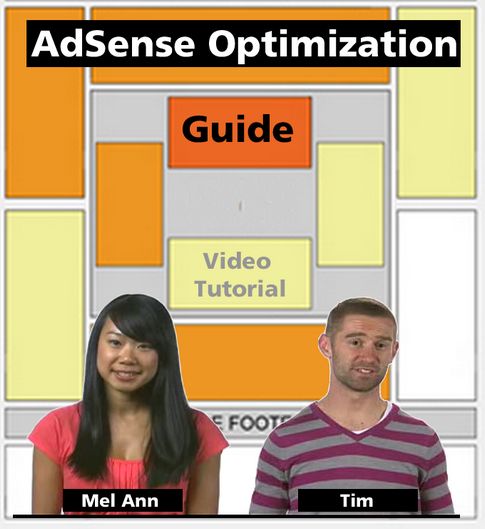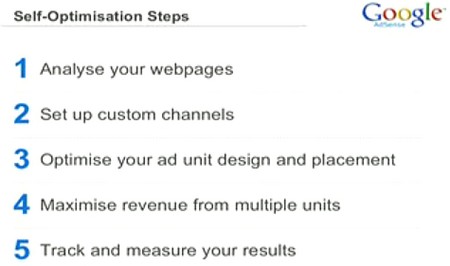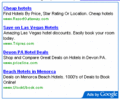 The video provides some very basic concepts and suggest simple strategic approaches to general AdSense optimization that, as far as I can tell, are all right on the mark. These are again, all basic concepts of AdSense optimization and they are definitely targeted at those exposing themselves for the first time to this type of work.
What you should expect to find in it, are fundamental references for optimising AdSense performance - from analysing your page type, to choosing the right ad sizes and colors, and to how you should best monitor and track your results.
Also included, some general advice and tips on how to increase eCPM, without adversely affecting your community's experience on your web site pages.
This introductory video guide covers the following topics:
1. Analysing your webpage
2. Creating custom channels
3. Determining best ad design and placement
4. Maximizing ad units on a page
5. Tracking and measuring your results
Here the video and full text transcript:
The video provides some very basic concepts and suggest simple strategic approaches to general AdSense optimization that, as far as I can tell, are all right on the mark. These are again, all basic concepts of AdSense optimization and they are definitely targeted at those exposing themselves for the first time to this type of work.
What you should expect to find in it, are fundamental references for optimising AdSense performance - from analysing your page type, to choosing the right ad sizes and colors, and to how you should best monitor and track your results.
Also included, some general advice and tips on how to increase eCPM, without adversely affecting your community's experience on your web site pages.
This introductory video guide covers the following topics:
1. Analysing your webpage
2. Creating custom channels
3. Determining best ad design and placement
4. Maximizing ad units on a page
5. Tracking and measuring your results
Here the video and full text transcript:
Google AdSense Steps to Success
The Australian Google AdSense Team introduces the basic of AdSense video optimizationFull English Text Transcription Welcome to a step-by-step guide to making the most out of AdSense. My name is Mel Ann and I am an account manager on the AdSense team in Sidney Australia. Together with my colleague Tim we'll be running through a guide to successful AdSense optimization. One of the great things that Mel Ann and I we love about our job , is helping publishers maximize their Adsense performance via the optimization program. The two aims of the program are: 1) Increase your AdSense revenue and 2) Improve your community's experience on your web site. The optimization guide that follows is all about these two goals.
The Five Steps To Optimizing AdSense On Your Web Pages
Mel Ann: Let's go through the steps for optimizing your web pages. These five steps will take you through a complete optimization. And they are a good starting point for you to improve your AdSense performance. As optimization specialists,Tim and I go through these steps when looking at all our publishers accounts.- Firstly we analyze the content of a web page and determine how your users view the content.
- By using custom channels we also find out which ad units are performing or underperforming, by looking at the channel data available.
- Then we determine the optimum ad formats and placements of your ads such as color, position and size.
- We also make sure that you are getting the most out of having multiple ad units on a page.
- And by checking and measuring the results from when you implement it you will be able to say whether your optimization have made a difference to your AdSense performance.

1) Analyze Your Web Pages
 People read pages in different ways and their interaction with ads will depend on a few factors.
Ask yourself these questions:
a) What type of content do you have on your pages?
Some will interact with an article page differently than from a forum. And differently again with a video site.
b) Where is their attention likely to be focused?
If you have your most interesting content at the top of the page the best ad placement will be next to that content. You should place ads where your users are most likely to look and not hide them away at the corner of your page.
c) Ask yourself how you can integrate ads into this area without getting into your users way.
You want to protect your community experience with your web page and not clutter it with ads.
People read pages in different ways and their interaction with ads will depend on a few factors.
Ask yourself these questions:
a) What type of content do you have on your pages?
Some will interact with an article page differently than from a forum. And differently again with a video site.
b) Where is their attention likely to be focused?
If you have your most interesting content at the top of the page the best ad placement will be next to that content. You should place ads where your users are most likely to look and not hide them away at the corner of your page.
c) Ask yourself how you can integrate ads into this area without getting into your users way.
You want to protect your community experience with your web page and not clutter it with ads.
The AdSense Heatmap
This heatmap highlights the areas on a web page where ads perform well. Ads are ideally placed above the fold and close to your primary content. You should place ads where your users are most likely to look and not hide them away. At the end of the day, your knowledge about how your community interacts with your page will guide you on how to best apply these optimization techniques. When analyzing your pages it's also important to think about how advertisers will like to appear on your site. A great way to potentially increase your earnings is by making your site more appealing to advertisers. Earnings, or effective CPM (eCPM) can be increased by advertisers targeting your site in a placement targeting campaign. In a placement targeting campaign an advertiser bids more than all the ads in an ad unit to take up that entire unit with their ad. This is most often an image ad. But it could be video, Flash, or a text ad.
Is Your Site Advertiser Friendly?
The top three ways to ensure that your site is advertiser friendly are: 1) To opt-in to showing text as well as image ads 2) To have well designed and presented content 3) To use large ad units such as the 300x250 medium rectangle.
2) Set Up Custom Channels
 Custom channels allow you to categorize or group different ad units across your site for reporting purposes. They give you a better insight into how individual ad units are performing, and so that you can make decisions about placement, color and style and maximize your user engagement with the ads.
You can manage your custom channels in the "Channels" section, under the AdSense Setup tab.
So after analyzing your pages and determining the way you would like to place your ads make sure you also create a channel for individual ad unit placements. You will be able to compare performance between ad units.
For example by creating a custom channel to track all fo your leaderboard ad units as well as your medium rectangle ad units you will be able to say which ad sizes perform better, in terms of clickthrough rate or revenue.
Tracking individual ad unit metrics ensures that you have the best information possible for maximiming your AdSense performance.
Custom channels allow you to categorize or group different ad units across your site for reporting purposes. They give you a better insight into how individual ad units are performing, and so that you can make decisions about placement, color and style and maximize your user engagement with the ads.
You can manage your custom channels in the "Channels" section, under the AdSense Setup tab.
So after analyzing your pages and determining the way you would like to place your ads make sure you also create a channel for individual ad unit placements. You will be able to compare performance between ad units.
For example by creating a custom channel to track all fo your leaderboard ad units as well as your medium rectangle ad units you will be able to say which ad sizes perform better, in terms of clickthrough rate or revenue.
Tracking individual ad unit metrics ensures that you have the best information possible for maximiming your AdSense performance.
3) Optimize Your Ad Units Design and Performance
Advertisers love to use these formats in placement targetig campaigns as they are common industry standards. The three most popular are: a) The medium rectangle (300x250)
b) Wide skyscraper (160x600)

c) Leaderboard (720x90)
Appropriate Use of Colors
Colors play an important part in keeping your ads looking professional and a relevant part of your site. As text ads show approximately 70 to 80% of the time it is essential that they complement your site. There are several ways you can do this: Simple things like blending in the background of the ads with the color of your site and removing borders have proven in the past to have a significant impact upon clickthrough rate. Just be careful of not blending the ads too much so that they look like your site content. You can also try to highlight the links in the URL with shades that complement your site colors. Remember that tricking your audience to click on ads does not work in the long run and Google penalizes publishers whose users are not interacting properly with ads on page.
So let's summarize the key learnings from looking at ad design and placement.
- We have found that doing an analysis of how your users view information and enjoy the content on your site is absolutely essential to how you choose where to place your ads.
- It's important not to hide your Google ads. As users will actually find them useful if they can see them.
- Integrate your ads with your content and place them where they are visible. You will find that your actual clickthrough rate will actually improve.
- Choose colors for your ads so that they are easily distinguishable from content but still look like they belong to your site.
4) Maximize Revenue From Multiple Units
Now we will move on to how to maximize revenue from the existing ad units on a page. Of course the AdSense team is very wary to suggest you to plaster your pages with ads, so to maximize the yeld from multiple units, we recommend finding ut which unit is performing best on your page. You can do this by setting up custom channels to determine which ad format is outperfoming the rest in terms of having the highest clickthrough rate and eCPM. The first ad unit on a page always shows the highest paying ads. The ones that won the ad auction. These ads pay you the most per click. The first unit on the page is defined as the first instance of HTML code on your page. Place that ad unit first in your HTML so that it will receive the highest paying ads. This will maximize the yield that you can receive from multiple ad units on a page. So for example if you have a leaderboard at the top of your page but a mdeium rectangle that is placed half-way down outperfoms it, then the higher paying ads are better being placed in that medium rectangle where your users click more. If you are comfortable with HTML and JavaScript you probably can figure out a way to place the medium rectangle first in your HTML. However a good result can also be gained by removing the leaderboard from the top and placing it somewhere else on a page so that the medium rectangle appears first in your pages source code.5) Track and Measure Your Results
 Let's go over the best ways of tracking and measuring your optimization results. As I have mentioned previously, using AdSense channels is a great way to track AdSense performance at the individual ad unit level. This next section will detail how to use methods best.
I am sure everyone is familiar with the "Reports" tab in your AdSense account. To generate a report on your custom channels click on the Advanced Reports subtab. Select the "channel data" radio button and the channels that you would like to compare.
You also have the option of showing your results by date, channel, or both. Below you'll see your results.
In this example (see video) we have grouped results by date. This gives results for each day for all the custom channels you have selected.
Even more useful is grouping your results by channels. This allows you to compare different ad units based on placement, color or format. Success in using this feature depends on whether you have set up custom channels to track these ads in the first place.
In this example we are comparing the performance of your 160x600 skyscraper against the 300x250 medium rectangle. If we were to run these reports over a monthly time frame and see that the 300x250 medium rectangle is performing better, we may try first ad unit optimization, as discussed by Tim.
Generating "placement targeting reports" is done within the same panel. Simply select the "Show Data by" option and change it to individual ad units. This allows you to see which ad units are receiving placement targeted ads and whether your optimization has effectively improved your eCPM.
Let's go over the best ways of tracking and measuring your optimization results. As I have mentioned previously, using AdSense channels is a great way to track AdSense performance at the individual ad unit level. This next section will detail how to use methods best.
I am sure everyone is familiar with the "Reports" tab in your AdSense account. To generate a report on your custom channels click on the Advanced Reports subtab. Select the "channel data" radio button and the channels that you would like to compare.
You also have the option of showing your results by date, channel, or both. Below you'll see your results.
In this example (see video) we have grouped results by date. This gives results for each day for all the custom channels you have selected.
Even more useful is grouping your results by channels. This allows you to compare different ad units based on placement, color or format. Success in using this feature depends on whether you have set up custom channels to track these ads in the first place.
In this example we are comparing the performance of your 160x600 skyscraper against the 300x250 medium rectangle. If we were to run these reports over a monthly time frame and see that the 300x250 medium rectangle is performing better, we may try first ad unit optimization, as discussed by Tim.
Generating "placement targeting reports" is done within the same panel. Simply select the "Show Data by" option and change it to individual ad units. This allows you to see which ad units are receiving placement targeted ads and whether your optimization has effectively improved your eCPM.
Resources for AdSense Optimization
 Let's look through some of the great resources available for AdSense optimization.
In the AdSense Help Center you'll find the answers to our most common questions as well as more techniques to help you improve your AdSense performance. Try searching for "optimizing AdSense" in the Help Center and walk through the easy to implement solutions for getting the most out of AdSense.
Google AdSense Help Forum is a place for you to learn and share the optimization techniques with other AdSense publishers. You can browser previous threads and comments or post a new conversation on how to approach your Adsense optimization on your site.
If you have any questions about AdSense or if you would like more detail on AdSense optimization in general please feel free to contact the AdSense team by emailing adsense-support@google.com or go to the Help Center guide
Let's look through some of the great resources available for AdSense optimization.
In the AdSense Help Center you'll find the answers to our most common questions as well as more techniques to help you improve your AdSense performance. Try searching for "optimizing AdSense" in the Help Center and walk through the easy to implement solutions for getting the most out of AdSense.
Google AdSense Help Forum is a place for you to learn and share the optimization techniques with other AdSense publishers. You can browser previous threads and comments or post a new conversation on how to approach your Adsense optimization on your site.
If you have any questions about AdSense or if you would like more detail on AdSense optimization in general please feel free to contact the AdSense team by emailing adsense-support@google.com or go to the Help Center guide
Video by the Australian Google AdSense Team - "Five steps to optimising your AdSense performance" - YouTube link - Formatting, illustrations and full English text transcription by Robin Good.

